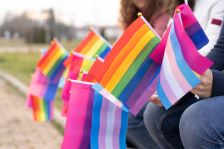 This article examines how sexual minority middle schoolers use social media, who they are connected to and for what purposes, and the associations between these behaviors and mental wellbeing, compared to their heterosexual peers.
This article examines how sexual minority middle schoolers use social media, who they are connected to and for what purposes, and the associations between these behaviors and mental wellbeing, compared to their heterosexual peers.
Dr. Charmaraman, Hodes, and Richer surveyed 1,033 early adolescents aged 10-16 from four middle schools in the Northeast U.S., comparing the responses of sexual minorities (24.3% of the sample with known sexual orientation) to their heterosexual peers.
The researchers found that sexual minorities reported having smaller networks on their favorite social media site, and less often responded positively when friends shared good news or tried to make friends feel better when they shared bad news. However, unlike heterosexual youth, sexual minorities more often reported joining a group or online community to make themselves feel less alone. They had higher averages of loneliness and social isolation than heterosexual students, and were also twice as likely to have tried to harm themselves in the past and more likely to have symptoms of depression. About 39.1% of sexual minorities had no one to talk to about their sexual orientation. They were 1.5 times more likely to have joined a social media site their parents would disapprove of and they were more likely to report seeing online videos related to self-harm.
Given previous reports of supportive and safe online spaces for sexual minority youth, these findings demonstrate that these youth prefer to maintain small, close-knit online communities (apart from their families) to express themselves, particularly when reaching out to online communities to reduce loneliness.
Findings from this study have been featured in ABC News, The Conversation, Academic Minute, Actively Learn, Let's Go There podcast, and the Women Change Worlds blog.
This study was supported by the Eunice Kennedy Shriver National Institute of Child Health and Human Development: R15HD094281-01. The content is solely the responsibility of the authors and does not necessarily represent the official views of the National Institutes of Health. Support was also provided by the Wellesley Centers for Women Class of 1967 Internship Program and by Children and Screens: Institute of Digital Media and Child Development, which provided pilot seed funds before the National Institutes of Health award.

